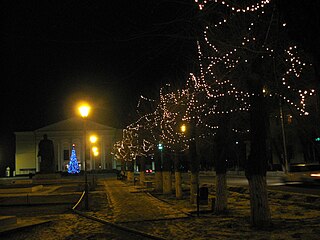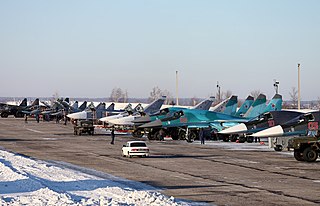
The Sukhoi Su-27 is a Soviet-origin twin-engine supersonic supermaneuverable fighter aircraft designed by Sukhoi. It was intended as a direct competitor for the large US fourth-generation jet fighters such as the Grumman F-14 Tomcat and McDonnell Douglas F-15 Eagle, with 3,530-kilometre (1,910 nmi) range, heavy aircraft ordnance, sophisticated avionics and high maneuverability. The Su-27 was designed for air superiority missions, and subsequent variants are able to perform almost all aerial warfare operations. It was designed with the Mikoyan MiG-29 as its complement.

The Soviet Air Forces were one of the air forces of the Soviet Union. The other was the Soviet Air Defence Forces. The Air Forces were formed from components of the Imperial Russian Air Service in 1917, and faced their greatest test during World War II. The groups were also involved in the Korean War, and dissolved along with the Soviet Union itself in 1991–92. Former Soviet Air Forces' assets were subsequently divided into several air forces of former Soviet republics, including the new Russian Air Force. The "March of the Pilots" was its marching song.

The Sukhoi Su-35 is the designation for two improved derivatives of the Su-27 air-defence fighter. They are single-seat, twin-engine, supermaneuverable air superiority fighters, designed by the Sukhoi Design Bureau and built by Sukhoi.

The Sukhoi Su-25 Grach is a subsonic, single-seat, twin-engine jet aircraft developed in the Soviet Union by Sukhoi. It was designed to provide close air support for Soviet Ground Forces. The first prototype made its maiden flight on 22 February 1975. After testing, the aircraft went into series production in 1978 in Tbilisi in the Georgian Soviet Socialist Republic.

The Sukhoi Su-30 is a twin-engine, two-seat supermaneuverable fighter aircraft developed in the Soviet Union by Russia's Sukhoi Aviation Corporation. It is a multirole fighter for all-weather, air-to-air interdiction missions. The Russian Aerospace Forces (VKS) were reported to have 130 Su-30SMs in operation as of 2024.

The Sukhoi Su-34 is a Soviet-origin Russian twin-engine, twin-seat, all-weather supersonic medium-range fighter-bomber/strike aircraft. It first flew in 1990, intended for the Soviet Air Forces, and it entered service in 2014 with the Russian Air Force.

The Yakovlev Yak-130 is a subsonic two-seat advanced jet trainer and light combat aircraft originally developed by Yakovlev and Aermacchi as the "Yak/AEM-130". It has also been marketed as a potential light attack aircraft. Development of the aircraft began in 1991 and the maiden flight was conducted on 25 April 1996. In 2002, it won a Russian government tender for training aircraft and in 2010 the aircraft entered service with the Russian Air Force. As an advanced training aircraft, the Yak-130 is able to replicate the characteristics of several 4+ generation fighters as well as the fifth-generation Sukhoi Su-57. It can also perform light-attack and reconnaissance duties, carrying a combat load of 3,000 kg (6,600 lb).

The Russian Air Force is a branch of the Russian Aerospace Forces, the latter being formed on 1 August 2015 with the merging of the Russian Air Force and the Russian Aerospace Defence Forces. After the dissolution of the Soviet Union, the reborn Russian armed forces began to be created on 7 May 1992 following Boris Yeltsin's creation of the Ministry of Defence. However, the Russian Federation's air force can trace its lineage and traditions back to the Imperial Russian Air Service (1912–1917) and the Soviet Air Forces (1918–1991).

The Sukhoi Su-57 is a twin-engine stealth multirole fighter aircraft developed by Sukhoi. It is the product of the PAK FA programme, which was initiated in 1999 as a more modern and affordable alternative to the MFI. Sukhoi's internal designation for the aircraft is T-50. The Su-57 is the first aircraft in Russian military service designed with stealth technology and is intended to be the basis for a family of stealth combat aircraft.

Akhtubinsk is a town and the administrative center of Akhtubinsky District in Astrakhan Oblast, Russia, located on the left bank of the Akhtuba River, 292 kilometers (181 mi) north of Astrakhan, the administrative center of the oblast. Population: 41,853 (2010 Census); 45,542 ; 50,261 (1989 Soviet census); 30,000 (1968).

Lipetsk Air Base is an air base in Lipetsk Oblast, Russia located 12 km northwest of Lipetsk. It is the chief combat training center of the Russian Aerospace Forces, analogous to the United States Air Force's Nellis Air Force Base. The base is made up of two medium-sized airfields joined together.

Bagay-Baranovka is an air base in Saratov Oblast, Russia located 2 km south of Sennoy. It is a small training base, with training airspace about 5–10 km to the east and home to the 395th Independent Test Aviation Squadron of the 929th State Flight Test Centre named for V. P. Chkalov.
The Forces of central subordination of the Russian Air Force report directly to the Headquarters of the Air Force. This listing is believed to be accurate as of August 2008.

The Turkmen Air Force is the air force branch of the Armed Forces of Turkmenistan. It was formed from former Soviet Air Forces units within that region of the Turkestan Military District. The Turkmen Air Force inherited some 300 Soviet aircraft, and has pilots trained in Ukraine.

The 4th Centre for Combat Employment and Retraining of Personnel VVS of the Russian Aerospace Forces is a research, training, and instructional centre. It was formed at Tambov on 19 April 1953. In 1954 it was transferred to Voronezh Malshevo and 1960 to the Lipetsk air base, and then was transformed into the 4th Centre deployment and retraining flight personnel of the Air Force. It was part of the Air Forces of the Moscow Military District for decades.
The 54th Guards Fighter Aviation Regiment was an aviation regiment of the Soviet Air Forces during World War II and the Cold War, which became part of the Soviet Air Defense Forces and the Russian Aerospace Forces.

The Sukhoi S-70 Okhotnik-B, also referred to as Hunter-B, is a Russian heavy unmanned combat aerial vehicle (UCAV) that was being developed during the 2010s by Sukhoi and Russian Aircraft Corporation MiG. Several prototypes underwent flight testing in 2019–2023 and, as of January 2024, it was projected that production could begin as early as the second half of 2024.

Kirovske is a Russian Aerospace Forces base located in Kirovske Raion, near the town of Kirovske, in Russian occupied Crimea, Ukraine.

Akhtubinsk is military base, which belongs to Russian aviation research and testing military institution 929th State Flight Test Centre named for V. P. Chkalov located at Akhtubinsk, Astrakhan Oblast, Russia.


















